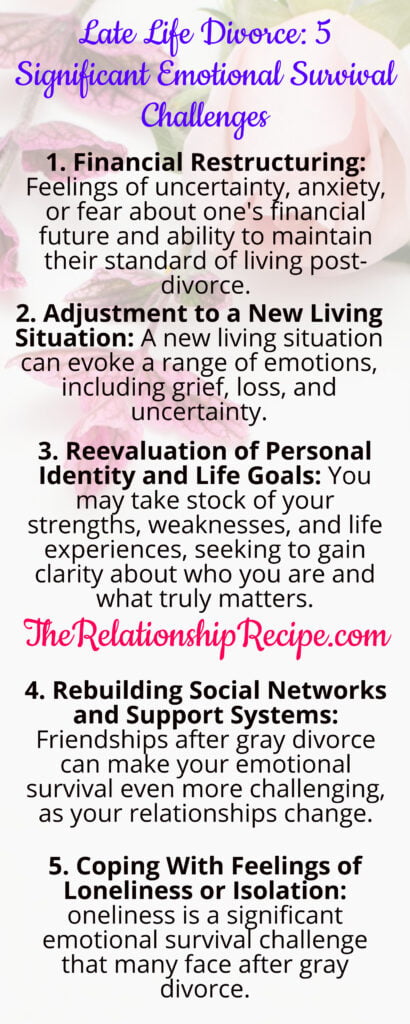The Emotional Terrain of Gray Divorce: Strategies for Coping and Emotional Survival
Late life divorce, often referred to as gray divorce, presents unique emotional survival challenges that can be daunting to navigate. You may be struggling with the end of a long-term relationship or adjusting to newfound independence, but the steps needed towards your emotional survival from gray divorce can be profound.
In this comprehensive article, I explore the emotional landscape of late life divorce, offer coping strategies, and discuss key factors for emotional survival.
5 Emotional Survival Challenges of Late Life Divorce
Late life divorce brings forth a myriad of emotional survival challenges. For many, the end of a decades-long marriage can evoke feelings of grief, loss, and uncertainty. Suddenly finding oneself single after years of partnership can be disorienting and emotionally overwhelming.
There may be a sense of unforeseen gray divorce regrets or questioning of life choices, as we reflect on the trajectory of our marriage and what could have been.
Late life divorce often results in significant changes and challenges, including:
1. Financial Restructuring, as Assets Accumulated Over the Years are Divided
In the context of gray divorce, financial restructuring is a significant aspect that requires careful consideration and planning. Unlike divorces that occur earlier in life, where couples may have fewer assets and liabilities, gray divorce often involves the division of substantial assets accumulated over decades of marriage.
Although it’s only “stuff,” it’s also memories and the passage of time, that are attached to them, which can make our emotional survival during this time challenging at best.
~The Relationship Recipe
Emotional Impact: Beyond the practical considerations, financial restructuring in late life divorce can have significant emotional ramifications. It may evoke feelings of uncertainty, anxiety, or fear about one’s financial future and ability to maintain their standard of living post-divorce. Seeking emotional support and guidance during this process is essential for navigating these complex emotions.
Asset Division: One of the primary challenges of gray divorce is dividing assets acquired during the marriage. This may include real estate properties, retirement accounts, investments, business interests, and valuable possessions. Determining how to fairly divide these assets can be complex and may require the assistance of financial professionals or mediators.
Retirement Accounts: Dividing retirement accounts, such as 401(k)s, IRAs, and pension plans, can be particularly intricate. Couples must navigate the process of valuing these accounts and determining how to equitably distribute them between spouses while also considering tax implications and future financial stability.
Debt Obligations: Alongside assets, couples must also address any debts accumulated during the marriage, such as mortgages, credit card debt, or loans. Determining responsibility for these obligations and how to manage them post-divorce is essential for both parties’ financial well-being.
Alimony and Spousal Support: In some gray divorce cases, one spouse may be entitled to alimony or spousal support to help maintain their financial stability post-divorce, especially if there is a significant disparity in income or earning potential between the spouses.
Estate Planning: Divorcing later in life often necessitates updating estate plans to reflect changes in beneficiaries, powers of attorney, and asset distribution preferences. Individuals should review and revise their estate planning documents, including wills and trusts, to ensure they align with their post-divorce wishes and circumstances.
Long-Term Financial Planning: Gray divorce requires us to reassess our long-term financial goals and plan accordingly. This may involve adjusting retirement savings strategies, revisiting investment portfolios, and seeking professional financial advice to ensure financial security and stability in the years ahead.
While these financial issues may not fall under the emotional survival category – dealing with them can be emotionally fraught with difficulties that can push us to our absolute limits.
2. Adjustment to a New Living Situation
Adjusting to a new living situation is a significant aspect of gray divorce, often requiring us to navigate changes in our housing arrangements, lifestyle, and sense of stability.
Here’s how the adjustment process unfolds in the context of gray divorce:
Emotional Impact: Adjusting to a new living situation can evoke a range of emotions, including grief, loss, and uncertainty. You may mourn the loss of the family home and the memories associated with it, as well as grapple with feelings of loneliness or isolation in the new living environment. It’s essential to give oneself time to process these emotions and seek support from friends, family, or a therapist if needed.
Housing Transitions: Following a gray divorce, we may find ourselves needing to downsize or relocate to a new home. This transition can be emotionally challenging, especially if you’ve lived in the family home for many years. Downsizing may involve decluttering belongings, selling the family home, and moving into a smaller residence that better suits their new lifestyle and financial circumstances.
Financial Considerations: Downsizing or relocating often has significant financial implications. You may need to carefully assess your housing options and consider factors such as affordability, proximity to amenities, and future housing needs. You may also need to navigate the process of selling or dividing property acquired during the marriage, including real estate assets and vacation homes.
Emotional Impact: Adjusting to a new living situation can evoke a range of emotions, including grief, loss, and uncertainty. We may mourn the loss of the family home and the memories associated with it, as well as struggle with feelings of loneliness or isolation in a new living environment. It’s essential to give oneself time to process these emotions and seek support from friends, family, or a therapist if needed.
Practical Considerations: Transitioning to a new living situation involves a range of practical considerations, such as arranging for movers, updating address information, transferring utilities, and familiarizing oneself with the new neighborhood or community. Planning ahead and creating a checklist can help streamline the moving process and alleviate some of the stress associated with relocation.
Social Support: Building a support network in the new living environment is essential for adapting to the changes brought about by gray divorce. You may seek out opportunities to connect with neighbors, join community groups or clubs, or participate in social activities that align with your interests and hobbies. Cultivating new friendships and relationships can help create a sense of belonging and support during the transition.
Creating a New Routine: Adjusting to a new living situation often involves establishing a new daily routine and rhythm of life. We may need to adapt to changes in our daily schedule, household responsibilities, and leisure activities. Embracing new routines and finding activities that bring joy and fulfillment can help you adjust to new circumstances and embrace newfound independence.

3. Reevaluation of Personal Identity and Life Goals
Reevaluating personal identity and life goals is a fundamental aspect of gray divorce, as we navigate the process of rediscovering ourselves and defining our aspirations for the next chapter of our lives. Here’s how this reevaluation unfolds in the context of gray divorce:
Self-Reflection: Gray divorce prompts us to engage in deep self-reflection, questioning our values, beliefs, and priorities. You may take stock of your strengths, weaknesses, and life experiences, seeking to gain clarity about who you are and what truly matters.
Rediscovering Identity: Divorcing later in life provides an opportunity for you to rediscover and redefine your sense of self. You may explore aspects of your identity that were overshadowed or suppressed during your marriage, reconnecting with long-forgotten passions, interests, and talents.
Clarifying Life Goals: Gray divorce prompts us to reassess their life goals and aspirations, considering what you want to achieve and experience in the years ahead. You may set new goals for personal growth, career advancement, travel, or relationships, aligning your aspirations with a newfound sense of identity and purpose.
Embracing Change: Embracing change is an integral part of the reevaluation process, as we let go of outdated beliefs or expectations and embrace new possibilities for their future. You may adopt a growth mindset, viewing divorce as an opportunity for personal transformation and renewal rather than solely a source of loss or upheaval.
Cultivating Self-Compassion: Navigating the reevaluation process can be emotionally challenging, as we confront difficult emotions and uncertainties about the future. Practicing self-compassion and self-care is essential, offering oneself kindness, understanding, and forgiveness as we navigate this transformative journey.
4. Rebuilding Social Networks and Support Systems
Navigating friendships after gray divorce can make your emotional survival even more challenging, as you may experience shifts in social networks and support systems. Here’s how friendships may evolve and sometimes fail, and how you can work towards rebuilding social connections:
Loss of Mutual Connections: In some cases, mutual friends may feel pressured to choose sides or may simply drift away as they navigate their own feelings about the divorce. This can lead to a sense of loss and isolation for both parties involved in the divorce, as they may feel abandoned or misunderstood by friends they once considered close.
Diverging Interests: After divorce, individuals may find that their interests and priorities have shifted, leading to a misalignment with friends who no longer share their values or lifestyle choices. This can create distance in friendships as individuals seek out new connections that better reflect their current identity and aspirations.
Stigma or Judgment: Unfortunately, divorce, especially later in life, can still carry a social stigma in some circles. Individuals may experience judgment or disapproval from friends who hold traditional views about marriage and divorce. This can strain friendships and lead to feelings of alienation or rejection.
Emotional Support: Rebuilding social networks after gray divorce is essential for emotional survival, as friendships provin essential source of support and companionship during times of transition. However, individuals may find that some friendships falter due to a lack of understanding or empathy from friends who have not experienced divorce themselves.
Seeking New Connections: In addition to reconnecting with existing friends, individuals may benefit from seeking out new connections and communities that align with their current interests and values. This could involve joining clubs, groups, or activities where they can meet like-minded individuals and forge new friendships based on shared interests.
5. Coping With Feelings of Loneliness or Isolation
Coping with feelings of loneliness or isolation is a significant emotional survival challenge that many individuals face after gray divorce. Here’s how these emotions manifest and strategies for managing them:
Loss of Partner: After a gray divorce, we may grapple with the profound loss of our long-term partner and the companionship they once enjoyed. Suddenly finding oneself living alone can exacerbate feelings of loneliness and isolation, especially if the marriage was a central aspect of their social support system.
Empty Nest Syndrome: For individuals who divorce later in life, the departure of adult children from the family home may coincide with the end of their marriage. This combination of life transitions can intensify feelings of loneliness and isolation, as individuals navigate an empty nest and the absence of their former partner.
Cultural Stigma: Despite societal shifts in attitudes towards divorce, there can still be a lingering stigma surrounding gray divorce in some cultural or religious communities. Individuals may internalize this stigma and feel ashamed or embarrassed about their marital status, further exacerbating feelings of loneliness and isolation.
Physical Health: Loneliness and isolation can take a toll on both emotional survival as well as our physical health, contributing to increased stress levels, disrupted sleep patterns, and heightened risk of chronic health conditions. It’s essential for us to prioritize self-care and seek out social connections to mitigate the negative impact of loneliness on our overall well-being.

Emotional Survival Tips for a Late Life Divorce
How you handle and prepare for your emotional survival for a later-life divorce requires introspection, self-awareness, and a willingness to confront difficult emotions. It can be essential for healing time and positive outcomes once the dust has settled.
Reflect on your reasons for seeking divorce and consider how you can cope with the emotional survival challenges ahead. While it’s natural to experience regrets or doubts about the decision to divorce, focus on the potential for growth and renewal that lies ahead.
Preparing emotionally for a late life divorce involves several key steps:
Self-reflection: Take time to reflect on your feelings and reasons for considering divorce. Understand your emotions and motivations before making any decisions.
Seek support: Reach out to friends, family, or a therapist for emotional support and guidance. Having a support network can provide comfort during this challenging time.
Educate yourself: Learn about the divorce process and potential challenges you may face. Knowledge can help you feel more empowered and prepared to navigate the journey ahead.
Practice self-care: Prioritize self-care activities that promote emotional well-being, such as exercise, meditation, and hobbies. Taking care of yourself physically and emotionally is essential during times of stress.
Consider counseling: Individual or couples counseling can help you explore your feelings, communicate effectively with your spouse, and navigate the challenges of emotional survival during divorce.
Plan for the future: Start thinking about your goals and aspirations for life after divorce. Having a vision for the future can provide motivation and hope during difficult times.
Stay flexible: Understand that emotions may fluctuate throughout the divorce process. Stay flexible and open-minded as you adapt to the changes in your life.
Focus on the positives: While divorce can be challenging, it also presents opportunities for personal growth and self-discovery. Focus on the positives and look for ways to create a fulfilling life post-divorce.
Seek legal guidance: Consult with a divorce attorney to understand your rights and options. Having a clear understanding of the legal process can alleviate some of the anxiety associated with divorce.
Take things one step at a time: Divorce is a process, and it’s essential to take things one step at a time. Be patient with yourself and trust that you have the strength to navigate this difficult period in your life.
Wrapping Up
No matter what your age, your emotional survival during a late life divorce is a journey that requires resilience, self-compassion, and support from others.
Gray divorce presents unique challenges, from financial restructuring to rebuilding social networks, but it also offers opportunities for personal growth, reinvention, and newfound independence.
By acknowledging and addressing the emotional complexities of divorce, we can navigate this journey with grace and resilience.
Remember that you are not alone in your struggles, and there are people and resources available to help you through this challenging time. Embrace change with courage and openness, and trust that you have the strength to create a fulfilling and rewarding life post-divorce. With time, patience, and self-care, you can emerge from gray divorce stronger, wiser, and ready to embrace the possibilities of the future.
Before You Go…
This is one of my favorite books on late life divorce. I read it several years ago and found it rather enlightening as it discusses the point of view from both men and women:
Gray Divorce: What We Lose and Gain from Mid-Life Splits
This book focuses on the challenges and changes of going through a late life divorce.
“Gray Divorce” discusses the rising trend of divorces among couples over 50. Jocelyn Elise Crowley explores reasons, impacts, and gender differences in this mid-life transition, shedding light on economic and social consequences. With insights on individual shifts, life expectancy, and economic disparities, Crowley advocates for supportive policies to aid those navigating this challenging journey.

https://sixtyandme.com/coping-gray-divorce/
This post may contain affiliate links. I earn from qualifying Amazon purchases at no extra cost to you.




